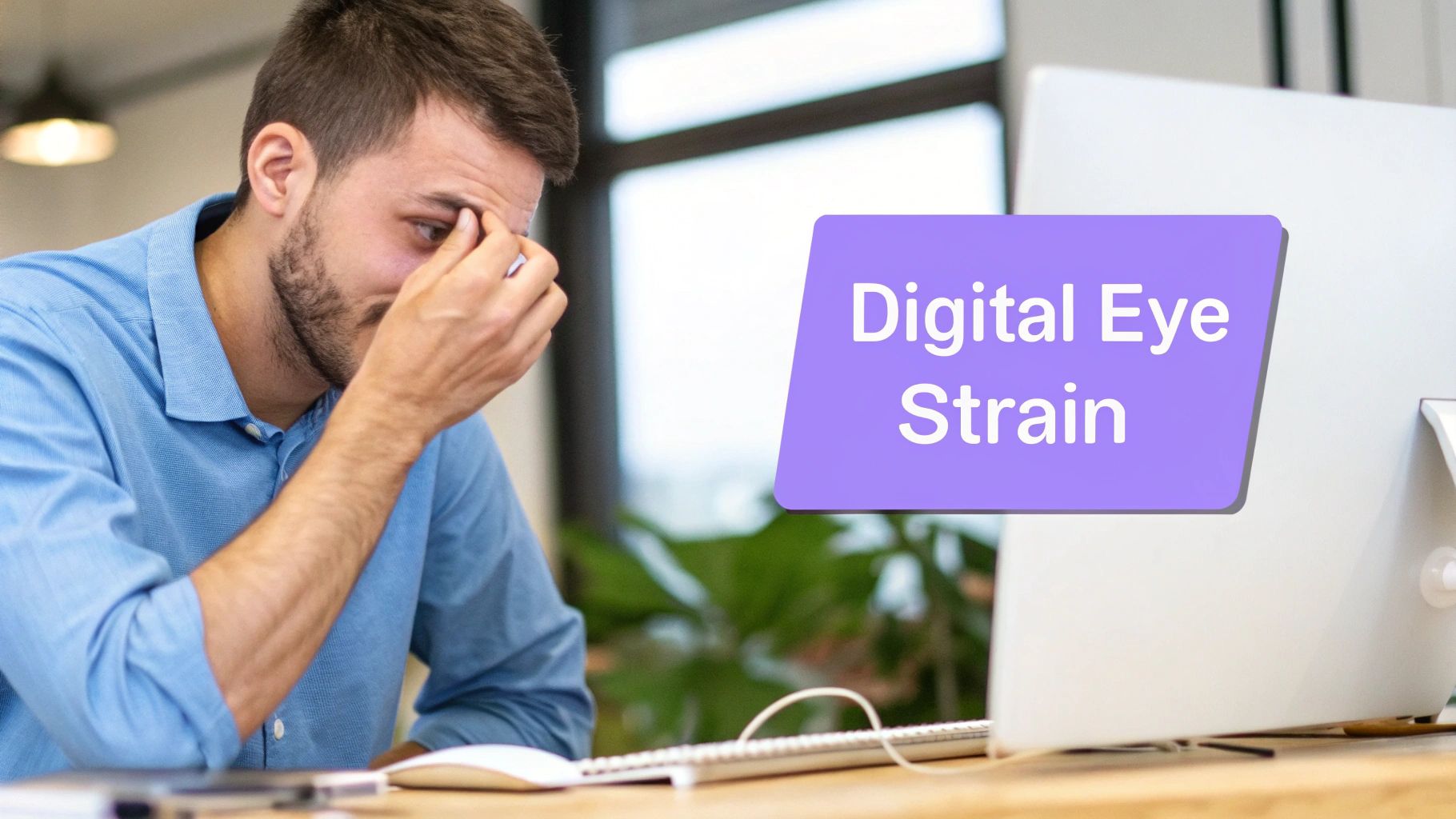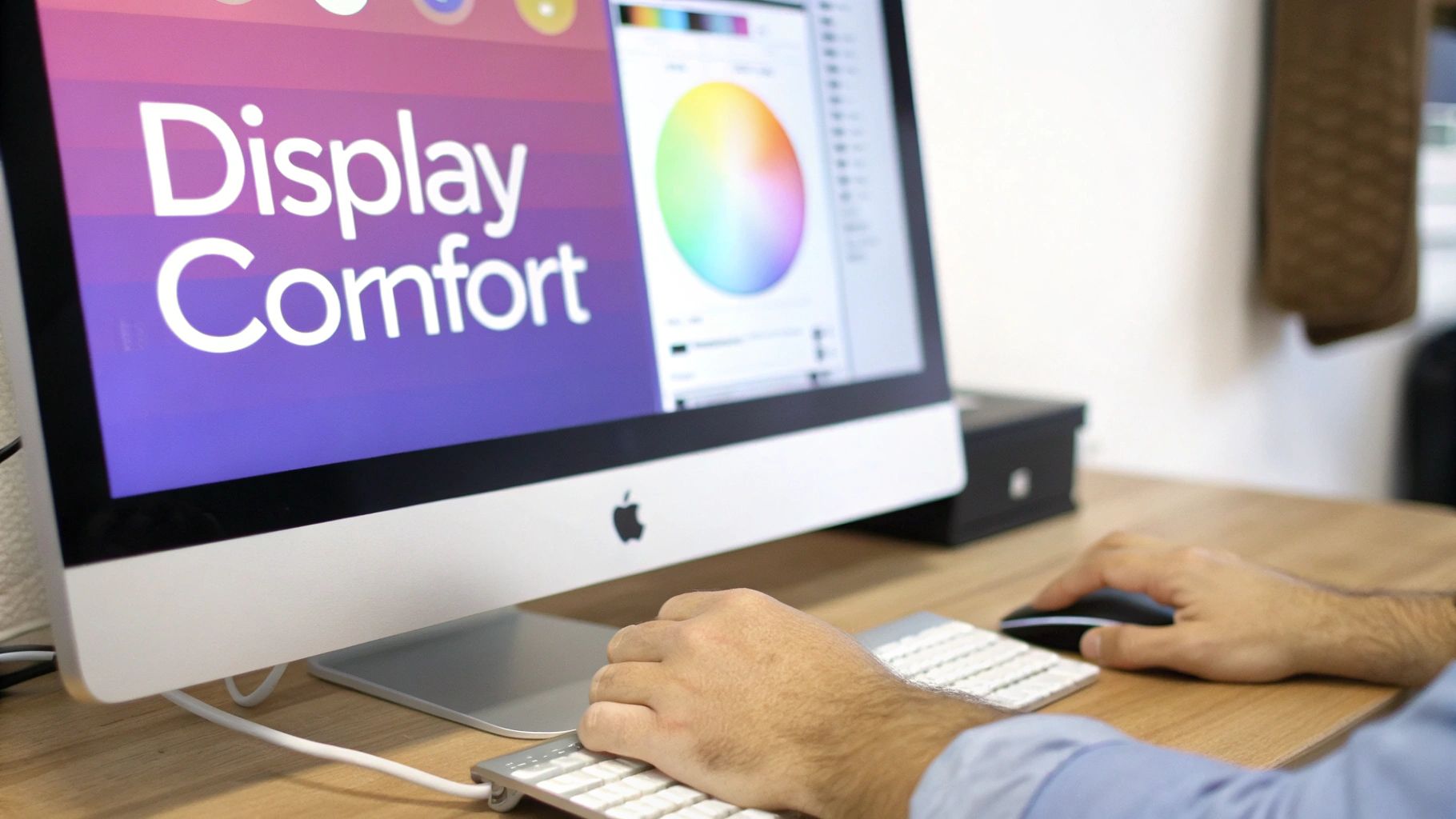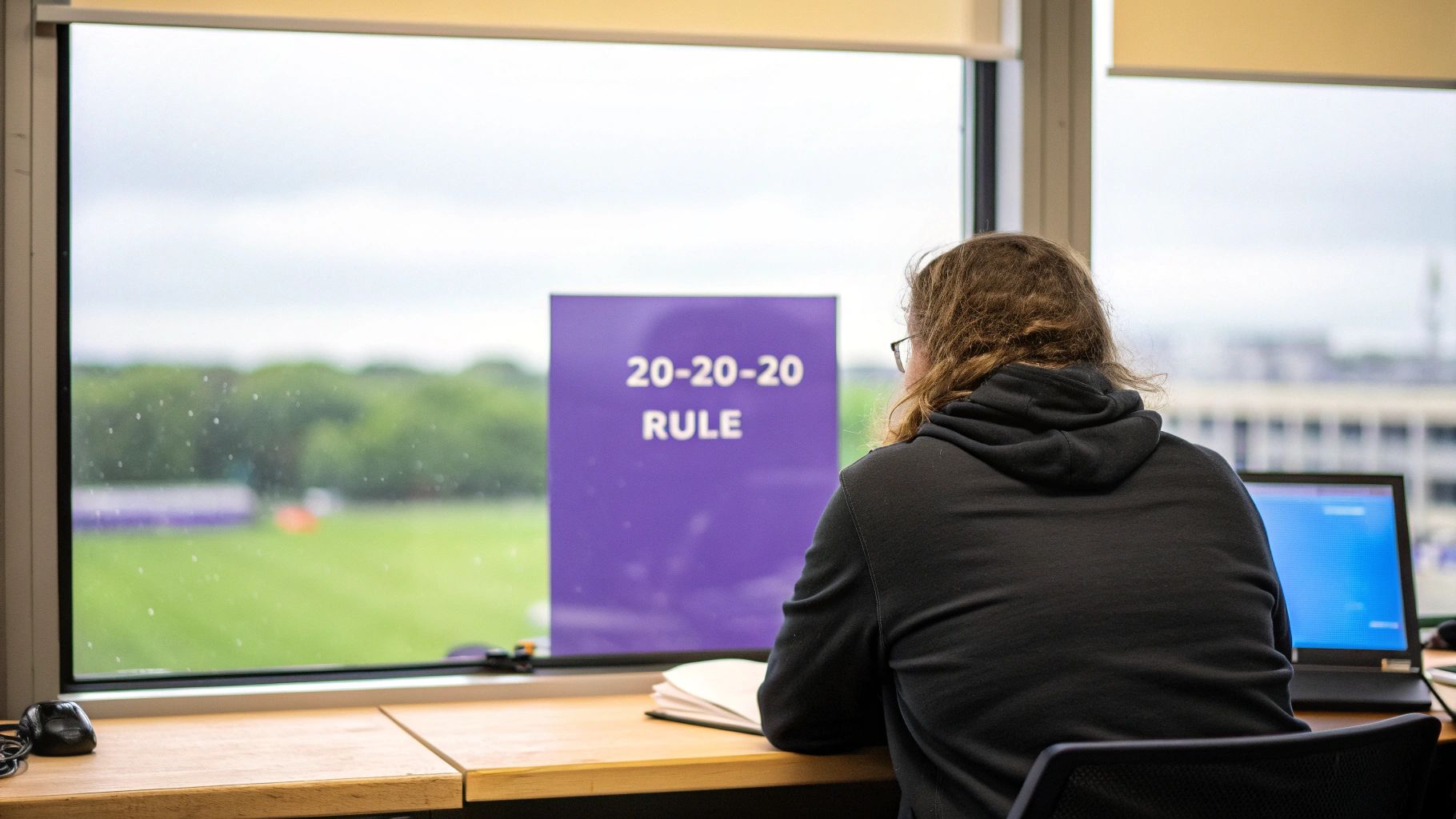Prevent Eye Strain from Computer: Quick, Easy Tips
Learn how to prevent eye strain from computer use with practical tips on desk setup, screen settings, and daily habits that protect your vision.
If you've ever ended a long day at the computer with dry, aching, or blurry eyes, you know exactly what digital eye strain feels like. It’s that gritty, tired sensation that seems to settle in after hours of staring at a screen. The official term for this is Computer Vision Syndrome (CVS), a collection of vision issues directly linked to prolonged use of our digital devices.
The core of the problem is how our eyes interact with screens. Unlike the sharp, stable letters in a printed book, the characters on a digital display are made of tiny pixels. These pixels don't have well-defined edges, which means our eyes have to constantly work—and rework—to maintain focus. Think of it as a subtle, non-stop workout for your eye muscles. It’s no wonder they feel exhausted by 5 p.m.

This constant refocusing is a major culprit, but it rarely acts alone. Usually, a combination of factors makes the strain even worse.
What's Really Causing Your Eye Strain?
Let's break down the common offenders. Recognizing these in your own workspace is the first real step toward finding relief.
- Bad Lighting: Glare is a huge problem. This can come from an overly bright overhead light or even a window behind you, creating harsh reflections on your screen that make your eyes struggle.
- Poor Screen Placement: If your monitor is too close, too far, too high, or too low, you’re forcing your eyes’ focusing system and your neck muscles to work overtime.
- Awkward Posture: Slouching in your chair doesn't just hurt your back; it also changes the distance and angle between your eyes and the screen, contributing to both neck and eye fatigue.
- Forgetting to Blink: This is a big one. When we're absorbed in our work, we tend to stare. In fact, studies show we blink up to 66% less while looking at a screen. This leads directly to dry, irritated eyes.
The numbers are pretty telling. In the United States alone, it's estimated that 60–69% of adults report symptoms of digital eye strain. It’s a modern problem that has become incredibly common with the rise of screen-based work.
The great news? You don't have to just put up with it. Eye strain isn’t an inevitable side effect of a desk job.
For a deeper look into the symptoms and underlying causes, our guide on what Computer Vision Syndrome is is a great resource. But for now, let's focus on the practical changes you can make today to start feeling better.
Before we dive into the detailed strategies, here’s a quick overview of some simple fixes you can implement right away for immediate relief.
Quick Fixes for Immediate Eye Strain Relief
| Strategy | Primary Benefit | When to Use It |
|---|---|---|
| The 20-20-20 Rule | Reduces focusing fatigue | Every 20 minutes of screen time |
| Adjust Screen Brightness | Minimizes glare and harsh light | When your screen feels like a light source or is hard to see |
| Increase Font Size | Eases squinting and muscle strain | Anytime you find yourself leaning in to read text |
| Blink More Often | Prevents dry, gritty eyes | Consciously, throughout the entire workday |
These small adjustments can make a surprising difference in how your eyes feel at the end of the day. Now, let’s get into the specifics of how to build these habits and optimize your entire workspace for better eye health.
Build an Eye-Friendly Workspace

Your physical environment is the very foundation of comfortable screen time. Getting your workspace dialed in is one of the most powerful things you can do—a one-time fix that pays off every single day by stopping eye strain before it even starts. It’s less about splurging on fancy gear and more about being smart with positioning.
Think of your desk as your command center for eye comfort. The single most important factor? Your monitor's placement. A great rule of thumb is to sit an arm's length away from your screen, which usually lands somewhere between 20 to 28 inches. This is the sweet spot that allows your eyes to focus without having to work overtime.
Just as crucial is the height. You want the top of your screen to be at or just slightly below your eye level. Looking slightly downward is a more natural, relaxed position for your eyes. As a bonus, it also takes a ton of pressure off your neck and shoulders, which can be a major source of those tension headaches that often go hand-in-hand with eye fatigue.
Master Your Lighting
Glare is the absolute enemy of comfortable vision. It forces your eyes to constantly squint and struggle just to see what’s on the screen. The goal here is to create soft, ambient light that doesn't cause harsh reflections.
Take a look at your main light sources:
- Windows: The best placement for your desk is perpendicular to any windows. Putting your screen directly in front of or behind a window is a recipe for disaster—you'll either have bright sunlight blasting into your eyes or reflecting right off your monitor.
- Overhead Lights: If you’re stuck with harsh overhead fluorescent lights, a simple desk lamp with a warm bulb can make a world of difference. It gives you softer, indirect light exactly where you need it. Just be sure to position it so it doesn't create new glare on your screen.
A well-arranged workspace does more than just prevent eye strain; it creates a more productive and calming environment. The small details in your setup have a cumulative effect on your daily well-being.
Getting your desk right is a huge part of creating an inspiring home office that truly works for you. If you want a quick analysis of your current setup, our free desk ergonomics checker can give you some personalized pointers.
Fine-Tune Your Display Settings for Comfort

Just like you’d adjust your chair for back support, your digital workspace needs the same kind of attention. The screen you stare at all day can be a major source of irritation, but a few quick tweaks can make a world of difference and are one of the fastest ways to prevent eye strain from computer use.
First off, let's talk brightness. It’s a common mistake to just leave a monitor on its default setting, which is usually cranked way too high. Your screen shouldn't feel like you're staring into a lightbulb. It should blend in with the light in your room.
Here’s a simple trick I use: hold a white piece of paper next to your monitor. If your screen looks like a lamp compared to the paper, it’s too bright. If it looks grey and dull, it’s too dark. Tweak it until they match.
What about the text on the screen? If you catch yourself leaning in or squinting to read an email, the font is definitely too small. Bumping up the text size might feel a little weird at first, but your eye muscles will thank you for it almost immediately. Both Windows and macOS have system-wide settings that let you scale up text and improve contrast, making everything far easier to read.
Tame the Blue Light
For anyone who works into the evening, managing your screen's color temperature is a game-changer. That bright, cool blue light from our displays is fine during the day, but it’s pretty harsh on the eyes after sunset and can even mess with your sleep.
This is where built-in tools like "Night Shift" on Macs or "Night Light" on Windows are your best friends. They automatically warm up your screen's colors, shifting from blue tones to softer yellows and oranges as the day ends. This one change makes late-night screen time feel so much less abrasive.
Think of it like this: you wouldn't use harsh fluorescent lights to relax in your living room at night. You’d use a warm lamp. The same logic applies to your monitor.
This is a massive issue for younger people, especially students who are glued to devices for school and socializing. In fact, some studies show that digital eye strain affects nearly everyone in university, with over 70% reporting symptoms. You can dive into the full research on student eye health to see just how widespread this is. Taking a minute to dial in your display settings is a simple but powerful way to fight back.
Adopt Simple Habits for Lasting Relief

Even after you've set up a perfect desk and dialed in your screen settings, your eyes still need a chance to reset. The best defense against digital eye strain isn't just a one-time fix; it's about building small, consistent habits into your daily workflow.
The most well-known strategy is the 20-20-20 rule, and for good reason—it works. The concept is simple: for every 20 minutes you spend staring at a screen, you shift your gaze to an object at least 20 feet away for a full 20 seconds.
This isn't just about looking away. It's a physical release for the tiny muscles inside your eyes that have been clenched to maintain close-up focus. Think of it as a quick stretch break, but specifically for your eyes.
Beyond the 20-20-20 Rule
The 20-20-20 rule is a fantastic foundation, but you can layer in a few other "micro-habits" for even greater relief.
- Conscious Blinking: When we get locked into our work, our blink rate can drop by half. This is what leads to that dry, gritty feeling. Make a conscious effort to close your eyes slowly and completely every so often. It’s a surprisingly effective way to re-lubricate their surface.
- Palming for Darkness: Try this right now. Rub your hands together to create a little warmth, then gently cup them over your closed eyes without putting any pressure on the eyeballs. The combination of warmth and total darkness for just 30-60 seconds is incredibly soothing for overstimulated eyes.
Here's a powerful stat to keep in mind: One study revealed that taking work breaks shorter than 20 minutes made people 2.4 times more likely to report symptoms of digital eye strain. It really highlights how crucial these small pauses are.
Building these habits takes a bit of intention at first. A simple timer or an app like DeskBreak can provide the nudge you need until it becomes second nature. And if that screen time often spills over into tension headaches, learning some self-massage techniques for headaches can be a real game-changer, tackling one of the most common side effects of sustained focus.
Putting it all together can seem like a lot to remember, but a simple routine makes it manageable.
Your Daily Eye Care Routine
Here's what a proactive schedule could look like, weaving these small actions into your workday.
| Time / Frequency | Action | Why It Helps |
|---|---|---|
| Every 20 Minutes | Practice the 20-20-20 rule. | Relaxes eye muscles and prevents focus fatigue. |
| Every Hour | Do a 1-minute palming exercise. | Calms overstimulated photoreceptors in the retina. |
| Twice a Day | Perform conscious blinking for 30 seconds. | Restores the tear film and combats dryness. |
| End of Day | Gently massage temples and neck. | Releases tension that builds up from screen use. |
This isn't a rigid mandate, but rather a framework to help you make eye care an automatic part of your day, ensuring your eyes feel as fresh at 5 PM as they did at 9 AM.
Advanced Strategies for Serious Screen Users
When your entire career is built around a screen, the basic tips and tricks just don't cut it anymore. If you're staring at a monitor for eight or more hours a day, your eyes are working overtime, and you need to bring in some heavier-duty tools to prevent eye strain from computer work.
Think about investing in a pair of dedicated computer glasses. These are different from standard reading glasses; they're calibrated for the intermediate distance between you and your monitor. Make sure they have an anti-reflective (AR) coating—it makes a world of difference by cutting the harsh glare from office lights and windows.
Many of these glasses also feature blue light filters. While the jury is still out on exactly how they affect sleep, countless people I've talked to swear they feel less visual fatigue and general discomfort after a long day of wearing them.
Look Beyond the Screen at Your Overall Health
It's easy to forget that your eyes are part of a much bigger system. Even a slight, uncorrected vision problem can amplify digital eye strain tenfold. That's why a comprehensive eye exam every year isn't just a suggestion; it's essential for anyone with a screen-heavy job. Sometimes, a new prescription is the most effective fix you can find.
Your eyes don't work in isolation. Their health is directly tied to your body's overall wellness, from hydration to the nutrients you consume.
Finally, you can support your eyes from the inside. Dehydration is a surprisingly common cause of dry, irritated eyes, so keeping a water bottle on your desk is more than just a good habit—it's a preventive measure.
You can also boost your diet with nutrients known to support vision, like:
- Omega-3 fatty acids
- Lutein
- Zeaxanthin
Building these into your meals or taking supplements adds another powerful layer of defense against long-term strain.
Answering Your Top Questions About Eye Strain
Let's clear up some of the most common questions and myths I hear about computer eye strain. Knowing the facts helps you focus your energy on what actually makes a difference.
Are Blue Light Glasses Just Hype?
This is a hot topic, and the answer isn't a simple yes or no. While the jury is still out on whether blocking blue light itself is the magic bullet, one thing is certain: the anti-reflective coating on most computer glasses is fantastic at cutting down screen glare.
Glare is a huge, often overlooked, contributor to eye fatigue. So, while the "blue light" part gets all the attention, many people experience genuine relief simply because their glasses are finally tackling the glare.
Can All This Screen Time Cause Permanent Damage?
It’s a valid concern, but you can breathe a sigh of relief. For most of us, digital eye strain is a temporary problem. It’s uncomfortable, for sure—leading to headaches, fatigue, and that gritty-eye feeling—but there’s no solid evidence it causes permanent damage to your vision.
However, constant strain can aggravate underlying issues you might not even know you have. That’s why regular eye exams are so important.
Think of it like this: your eye muscles get sore from overuse, just like your leg muscles after a long run. The discomfort is a signal to rest, not a sign of permanent injury. Giving your eyes a break is the best form of recovery.
Is It Just Eye Strain, or Something More?
So, how do you tell the difference between normal screen fatigue and a more serious problem? It mostly comes down to recovery.
Typical eye strain should get better when you step away from the screen. If you're still dealing with persistent blurred vision, constant headaches, or seeing double long after you’ve logged off, it’s time to schedule a visit with an eye doctor. Those could be signs of an underlying vision issue that needs to be addressed.
If you're wondering where you stand, our free eye strain test can give you some quick insights. It's a great starting point for figuring out how your daily habits are impacting your eyes.
Ready to make healthy habits effortless? DeskBreak is a simple browser extension that reminds you to take perfectly-timed breaks to rest your eyes, stretch, and refocus. Get DeskBreak and start protecting your eyes today.